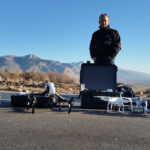Dr. Kam Leang is an Associate Professor of Mechanical Engineering at the University of Utah where he is the director of the University’s Design, Automation, Robotics, and Control Lab (DARC Lab.) Here, he answers seven questions about the hobbyist and potential commercial uses of small unmanned aerial systems, or drones, and addresses the technical and logistical challenges facing widespread drone use.
Tyler Shimko: What are the most promising emerging uses of drones domestically/commercially?
Dr. Kam Leang: In my opinion, I think emerging applications include: photography, videography, journalism, precision agriculture, search and rescue, first response, mapping, mining, and law enforcement.
Shimko: What technical challenges must be overcome in order for widespread commercial use to be realized?
Leang: One of the many challenges is establishing rules for safely operating drones in the National Airspace. Safety is top priority, so we have to figure how to operate these machines safely, especially in the presence of commercial aircraft. Additionally, there are concerns with privacy so policies need to be established to ensure privacy.
Shimko: What do you see as the most interesting problems in drone automation and control?
Leang: I can only speak of my interest, but for me the interesting problems include autonomy in complex and GPS-denied environments like indoor spaces, collision avoidance, efficiency, and coordination among multiple agents.
Shimko: Do you think we will see widespread use of fully autonomous drones in the future? If so, in what time scale?
Leang: The technology is advancing rapidly and currently drones are capable of flying on their own, even off-the-shelf systems can fly autonomously outdoors. I do expect that they will have more capabilities in the near future and become more versatile and adaptable, especially in complex environments.
Shimko: What’s the best way for a hobbyist to get involved with drones?
Leang: Visit diydrones.com
Shimko: What are the critical tools necessary to experiment with automation as it relates to drones (sensors, programming languages, cameras)?
Leang: Many commercial systems have hardware and software tools that allow you to experiment (see diydrones.com), but you have to keep in mind and follow regulations, especially set by the FAA on proper use and experimentation with drones.
Shimko: What has been the biggest development in drone automation technology in recent years?
Leang: I think one of the biggest advancements is small inertial measurement units (IMU) created for the cell-phone industry that’s being employed in flight controllers for many drones. The IMU is a critical component of many multi-rotor drones; IMUs are sensors that’s used by the on-board flight controller to help stabilize the aircraft. Without it, it would be very difficult for a human to effectively fly drones like multi-rotor aircraft. Also, advancement in microprocessor technology has also helped because now there are small microprocessors that are used in the design of the flight controllers.



